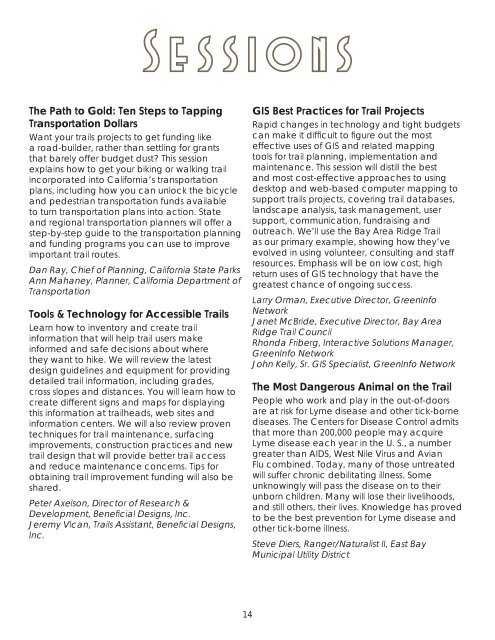the conference program - California State Parks - State of California
the conference program - California State Parks - State of California
the conference program - California State Parks - State of California
Create successful ePaper yourself
Turn your PDF publications into a flip-book with our unique Google optimized e-Paper software.
The Path to Gold: Ten Steps to Tapping<br />
Transportation Dollars<br />
Want your trails projects to get funding like<br />
a road-builder, ra<strong>the</strong>r than settling for grants<br />
that barely <strong>of</strong>fer budget dust? This session<br />
explains how to get your biking or walking trail<br />
incorporated into <strong>California</strong>’s transportation<br />
plans, including how you can unlock <strong>the</strong> bicycle<br />
and pedestrian transportation funds available<br />
to turn transportation plans into action. <strong>State</strong><br />
and regional transportation planners will <strong>of</strong>fer a<br />
step-by-step guide to <strong>the</strong> transportation planning<br />
and funding <strong>program</strong>s you can use to improve<br />
important trail routes.<br />
Dan Ray, Chief <strong>of</strong> Planning, <strong>California</strong> <strong>State</strong> <strong>Parks</strong><br />
Ann Mahaney, Planner, <strong>California</strong> Department <strong>of</strong><br />
Transportation<br />
Tools & Technology for Accessible Trails<br />
Learn how to inventory and create trail<br />
information that will help trail users make<br />
informed and safe decisions about where<br />
<strong>the</strong>y want to hike. We will review <strong>the</strong> latest<br />
design guidelines and equipment for providing<br />
detailed trail information, including grades,<br />
cross slopes and distances. You will learn how to<br />
create different signs and maps for displaying<br />
this information at trailheads, web sites and<br />
information centers. We will also review proven<br />
techniques for trail maintenance, surfacing<br />
improvements, construction practices and new<br />
trail design that will provide better trail access<br />
and reduce maintenance concerns. Tips for<br />
obtaining trail improvement funding will also be<br />
shared.<br />
Peter Axelson, Director <strong>of</strong> Research &<br />
Development, Benefi cial Designs, Inc.<br />
Jeremy Vlcan, Trails Assistant, Benefi cial Designs,<br />
Inc.<br />
SSessions e s s i o n s<br />
14<br />
GIS Best Practices for Trail Projects<br />
Rapid changes in technology and tight budgets<br />
can make it diffi cult to fi gure out <strong>the</strong> most<br />
effective uses <strong>of</strong> GIS and related mapping<br />
tools for trail planning, implementation and<br />
maintenance. This session will distill <strong>the</strong> best<br />
and most cost-effective approaches to using<br />
desktop and web-based computer mapping to<br />
support trails projects, covering trail databases,<br />
landscape analysis, task management, user<br />
support, communication, fundraising and<br />
outreach. We’ll use <strong>the</strong> Bay Area Ridge Trail<br />
as our primary example, showing how <strong>the</strong>y’ve<br />
evolved in using volunteer, consulting and staff<br />
resources. Emphasis will be on low cost, high<br />
return uses <strong>of</strong> GIS technology that have <strong>the</strong><br />
greatest chance <strong>of</strong> ongoing success.<br />
Larry Orman, Executive Director, GreenInfo<br />
Network<br />
Janet McBride, Executive Director, Bay Area<br />
Ridge Trail Council<br />
Rhonda Friberg, Interactive Solutions Manager,<br />
GreenInfo Network<br />
John Kelly, Sr. GIS Specialist, GreenInfo Network<br />
The Most Dangerous Animal on <strong>the</strong> Trail<br />
People who work and play in <strong>the</strong> out-<strong>of</strong>-doors<br />
are at risk for Lyme disease and o<strong>the</strong>r tick-borne<br />
diseases. The Centers for Disease Control admits<br />
that more than 200,000 people may acquire<br />
Lyme disease each year in <strong>the</strong> U. S., a number<br />
greater than AIDS, West Nile Virus and Avian<br />
Flu combined. Today, many <strong>of</strong> those untreated<br />
will suffer chronic debilitating illness. Some<br />
unknowingly will pass <strong>the</strong> disease on to <strong>the</strong>ir<br />
unborn children. Many will lose <strong>the</strong>ir livelihoods,<br />
and still o<strong>the</strong>rs, <strong>the</strong>ir lives. Knowledge has proved<br />
to be <strong>the</strong> best prevention for Lyme disease and<br />
o<strong>the</strong>r tick-borne illness.<br />
Steve Diers, Ranger/Naturalist II, East Bay<br />
Municipal Utility District

















